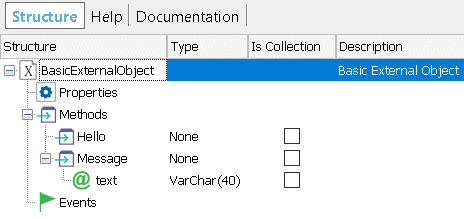Suppose you want to add a new feature to the iOS environment to show a 'non intrusive' message to the user.
You can create a Native Object within GeneXus; publish the desired method and properties to be called and do the implementation to integrate with the iOS platform.
Below there is a walkthrough you can follow to create an External object for the iOS platform.
You could use external implementations such as Toast-Swift or create your own. In this example, you will create your implementation to show a Toast message using a label and an animation.
Create a new Native object called BasicExternalObject.

Add a new method called Hello with the following values:
Is Static: True
Add a second method called Message with a Character argument.
Once the external object is saved, you can use it with the following syntax:
BasicExternalObject.Hello()
BasicExternalObject.Message(&text)
Now, you have to do some implementation to actually get this working.
You need to create an extension library where you declare your implementation details, dependencies and so on.
Please follow this document to create the Xcode project: Framework template for iOS User Controls or External Objects.
During execution, the GeneXus iOS application does not know the External Object implementation class, just the External Object method executed with its arguments.
You must provide a binding for a class that resolves the method execution.
Create a swift class named SampleExtensionLibrary with the following code; you are registering your External Object:
import GXCoreBL
@objc(SampleExtensionLibrary)
public class SampleExtensionLibrary: NSObject, GXExtensionLibraryProtocol {
public func initializeExtensionLibrary(withContext context: GXExtensionLibraryContext) {
GXActionExternalObjectHandler.register(BasicExternalObject.self, forExternalObjectName:BasicExternalObject.classIdentifier)
}
}
Then you need to actually implement the external object methods and properties, so create a BasicExternalObject swift class.
Notice the class must inherit from GXActionExternalObjectHandler and the following methods must be implemented:
override public class func handleActionExecutionUsingMethodHandlerSelectorNamePrefix() -> Bool {}
@objc public func gxActionExObjMethodHandler_Message(_ parameters: [Any])
@objc public func gxActionExObjMethodHandler_Hello()
Your implementation methods will vary depending on the method names associated with your External Object. Notice Message and Hello are related to this External Object definition. As a rule, the pattern you need to follow to implement the associated methods is as follows:
@objc <ClassVisibiliy> func gxActionExObjMethodHandler_<ExternalObjectMethodName>(_ parameters: [Any])
where:
- ClassVisibiliy: is related to the visibility assigned to your class.
- ExternalObjectMethodName: method name that must match the External Object definition.
- The method's parameter is optional and should be added only when the method has parameters (note that the Hello method in this external object does not have parameters).
The minimal implementation for the class would be:
public static let classIdentifier = "BasicExternalObject"
override public class func handleActionExecutionUsingMethodHandlerSelectorNamePrefix() -> Bool {
return true
}
@objc public func gxActionExObjMethodHandler_Message(_ parameters: [Any]) {
if let error = self.validateNumber(ofParametersReceived: UInt(parameters.count), expected: 1) {
self.onFinishedExecutingWithError(error)
return
}
guard let message = self.stringParameter(self.actionDescParametersArray![0], fromValue: parameters[0]) else {
self.onFinishedExecutingWithDefaultError()
return
}
self.showToast(message: message)
self.onFinishedExecutingWithSuccess()
}
@objc public func gxActionExObjMethodHandler_Hello() {
let hello = "Hello World!"
self.showToast(message: hello)
self.onFinishedExecutingWithSuccess()
}
The method to show the toast message should be as follows:
private func showToast(message : String) {
// Ideas from https://stackoverflow.com/questions/31540375/how-to-toast-message-in-swift
// First get the controller and its view
if let rootController = GXExecutionEnvironmentHelper.keyWindow?.rootViewController {
// Build the Toast sample
let size = rootController.view.frame.size
let toastLabel = UILabel(frame: CGRect(x: (size.width)/2 - 75, y: (size.height) - 100, width: 150, height: 35))
toastLabel.backgroundColor = UIColor.black.withAlphaComponent(0.6)
toastLabel.textColor = UIColor.white
toastLabel.textAlignment = .center;
toastLabel.font = UIFont(name: "Montserrat-Light", size: 12.0)
toastLabel.text = message
toastLabel.alpha = 1.0
toastLabel.layer.cornerRadius = 10;
toastLabel.clipsToBounds = true
rootController.view.addSubview(toastLabel)
UIView.animate(withDuration: 4.0, delay: 0.1, options: .curveEaseOut, animations: {
toastLabel.alpha = 0.0
}, completion: {(isCompleted) in
toastLabel.removeFromSuperview()
})
}
}
The GeneXus iOS application will call the handleActionExecutionUsingMethodHandlerSelectorNamePrefix method whenever it finds an action that calls the external object, to check if the action can be handled. Then depending on the method executed, it will automatically bind to your implementation:
gxActionExObjMethodHandler_<ExternalObjectMethodName>()
if the method does not have parameters, or otherwise:
gxActionExObjMethodHandler_<ExternalObjectMethodName>(_ parameters: [Any])
The first part of the method's implementation verifies that the number of parameters is as expected, and then tries to read the parameter value.
Then comes the actual implementation. In relation to the Toast sample, the actual implementation is done on the showToast function.
Done! You are ready to test your iOS BasicExternalObject external object with the two available methods.
In the example above, the External Object does not implement any properties, but if it had, they would be handled as if they were methods. That is, the property's getter will be called as:
gxActionExObjMethodHandler_<ExternalObjectPropertyName>()
The property's setter must have a 'set' prefix before the property name in the function definition (this prefix must be in lowercase), and will receive a parameter with the value to set:
gxActionExObjMethodHandler_set<ExternalObjectPropertyName>(_ parameters: [Any])
Make sure each External Object method calls the onFinishedExecutingWithSuccess, so the base class can call any other object to finish the method execution. For errors use onFinishedExecutingWithError function.
Use Xcode to debug the application calling the External object methods.
HowTo: create an External Object which triggers GeneXus events in iOS
iOS Flexible Client Deprecations